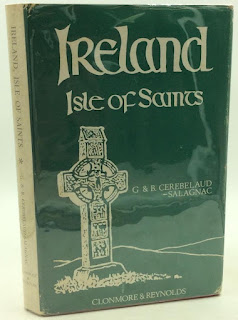July 31 is the feast of a County Dublin saint, Papán of Santry. As Canon O'Hanlon's entry for this saint in Volume VII of his Lives of the Irish Saints explains, a seventeenth-century hagiologist, Meredith Hanmer, whilst he preserved the memory of the saint's annual patron at Santry, confused him with a Belgian saint, Poppon of Stavelot. Actual details of our Irish saint's life are hard to come by but his memory lives on in Saint Pappin's holy well and also in the name of the townland of Poppintree or Pappan's tree. His name also occurs in connection with the feast of the Sons of Nadfraech, although it is not certain that he is one of this group. Canon O'Hanlon contents himself by giving us an historical sketch of the later medieval foundation which stood at Santry and ends by citing the evidence for the saint's feast day from the Irish calendars:
Article IV. — St. Papan, of Santry, County of Dublin.
[Supposed to be of the Fifth and Sixth Centuries.]
The Martyrology of Tallagh mentions, that veneration was given, at the 31st of July, to Papan, of Sentribh, now Santry, near the Irish metropolis. Here was one of the ancient sanctuaries of Ireland, with an old church or a monastery, long since gone, yet tradition preserves the memorial of this saint. Already, at the 25th of January, we have alluded to a St. Poppo, Pappan, or Poppon, supposed to have been Abbot of Stabuletum, who had a festival at that date; but, it is probable, the present St. Papan, of Santry, was a distinct person. Much obscurity, however, surrounds his history. According to what we find recorded, the father of this saint must have been Nathfriach— or more correctly Aengus. From this parentage, it must be inferred, that Papan was born in the fifth, and he probably lived on to the sixth, century. If we are to believe Dr. Meredith Hanmer, he was a native of Santry. In the townland of Poppintree, or Papan's Tree, so late as the beginning of the present century, the Patron of St. Papan, used to be held annually, on the 31st day of July. It may be supposed, that the former parish church of this pretty village stands on the site of the present Protestant church, which is surrounded by an ancient burying-ground. Whether, at this spot, an older ecclesiastical structure, than that erected in the latter part of the twelfth century, existed, we have now no means left for ascertaining; but, it seems very probable, since in the year 827, we find recorded in our ancient annals the death of Cormac, son of Muirgheas, Abbot of Seantrabh, interpreted Santry. After the Anglo Norman Invasion, however, King Henry II. of England, in granting the kingdom of Meath to Hugh De Lacy, included this neighbourhood within that charter. The latter feudal lord regranted the manors of Skryne and Santry to Adam de Feipo or Phepoe. Afterwards, this proprietor erected a church, consisting of a chancel and nave, separated or connected by a choir-arch. This he conveyed by deed to the Cistercian Abbey of St. Mary, in Dublin. It seems to us, that the Anglo-Norman Baron intended to dedicate the church of his foundation to St. Poppo or Poppon, Abbot of Stavelot, in the Low Countries, rather than to the more ancient Irish Saint bearing a nearly similar name. Wherefore, it is very probable, that both have been confounded in local popular tradition. In the family of De Feipo or Phepoe the manor of Santry continued until about 1375, when Johanna, daughter and heiress to Francis de Feipo or Phepoe, married Thomas Mareward, who was afterwards created Baron of Skryne. The village here seems to have grown up about the church, and it is mentioned in a Chancery Roll, which is dated 1379. In the year 1435, it is recorded as belonging to the Phepoe family; the manor at that time extending over the lands of Ballymun, Shillok, Little Ballycurry, Ballystrawan, &c. In many documents of the period, it gives its own name to the surrounding barony. In 1539, on the 28th of October, William Landey, the last Abbot of St. Mary's, Dublin, surrendered to King Henry VIII. all the estates of his Abbey, including those belonging to this parish, at that time when the dissolution of religious establishments took place. Then, the rectory, with a manse and a glebe, was of the annual value of £14 12s.; and in the sixteenth century, the manor of Santry passed from the Marewards, who had previously acquired the fee, to William Nugent, eighth Baron of Delvin, who had married Janet, the daughter and heiress of Walter Mareward, Baron of Serine. Afterwards, it was transmitted to the family of the Barrys, and later still to that of the Domviles. In 1609, the church of Santry was rebuilt, and it became the burial place for the latter families; while, in 1615, we learn, that the church was in good repair, but that the chancel was ruined. The present edifice was erected in 1709, on the ruins of the former one. At this same date, July 31st, the Martyrology of Donegal, has the simple entry, Papan. Marianus O'Gorman and the Martyrology of Tamlacht appear to be cited for confirmation of this insertion.
Content Copyright © Omnium Sanctorum Hiberniae 2012-2022. All rights reserved.






